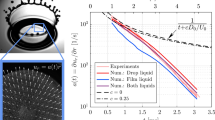Abstract
This paper investigates the behavior of microdroplets flowing in microchannels with a series of diffuser/nozzle structures. Depending on the imposed flow direction, the serial structures can act either as a series of diffusers or nozzles. Different serial diffuser/nozzle microchannels with opening angles ranging from 15° to 45° were considered. A 2D numerical model was employed to study the dynamics of the microdroplet during its passage through the diffuser/nozzle structures. The deformation of the microdroplet was captured using a level set method. On the experimental front, test devices were fabricated in polydimethylsiloxane using soft lithography. T-junctions for droplet formation, diffuser/nozzle structures and pressure ports were integrated in a single device. Mineral oil with 2% w/w surfactant span 80 and de-ionized water with fluorescent worked as the carrier phase and the dispersed phase, respectively. The deformation of the water droplet and the corresponding pressure drop across the diffuser/nozzle structures were measured in both diffuser and nozzle configurations at a fixed flow rate ratio between oil and water of 30. The results show a linear relationship between the pressure drop and the flow rate. Furthermore, the rectification effect was observed in all tested devices. The pressure drop in the diffuser configuration is higher than that of the nozzle configuration. Finally, the pressure measured results with droplet and without droplet were analyzed and compared.











Similar content being viewed by others
References
Beni G, Hackwood S (1981) Electro-wetting displays. Appl Phys Lett 38(4):207–209
Burns MA, Mastrangelo CH, Sammarco TS, Man FP, Webster JR, Johnson BN, Foerster B, Jones D, Fields Y, Kaiser AR (1996) Microfabricated structures for integrated DNA analysis. Science 93:5556–5561
Cho SK, Moon H, Kim CJ, Member IEEE, Member ASME (2003) Creating, transporting, cutting, and merging liquid droplets by electrowetting-based actuation for digital microfluidic circuits. J Microelectromech Syst 12(1):70–80
Darhuber AA, Valentino JP, Davis JM, Troian SM (2003) Microfluidic actuation by modulation of surface stresses. Appl Phys Lett 82(4):657–659
Garstecki P, Fuerstman MJ, Stone HA, Whitesides GM (2006) Formation of droplets and bubbles in a microfluidic T-junction—scaling and mechanism of break-up. Lab Chip 6:437–446
Gerlach T (1998) Microdiffusers as dynamic passive valves for micropump applications. Sens Actuators A 69:181–191
Gerlach T, Wurmus H (1995) Working principle and performance of the dynamic micropump. IEEE pp 221–225
Groisman A, Quake SR (2004) A microfluidic rectifier: anisotropic flow resistance at low Reynolds numbers. Phys Rev Lett 92: 094501-1–094501-4
Heschel M, Mullerborn M, Bouwstra S (1997) Fabrication and characterization of truly 3-D diffuser/nozzle microstructures in silicon. J Microelectromech Syst 6(1):41–47
Lehmann U, Hadjidj S, Parashar VK, Vandevyver C, Rida A, Gijs MAM (2006) Two-dimensional magnetic manipulation of microdroplets on a chip as a platform for bioanalytical applications. Sens Actuators B 117:457–463
Nguyen NT, Huang XY (2001) Miniature valveless pumps based on printed circuit board technique. Sens Actuators A 88:104–111
Nguyen NT, Huang XY (2005) Thermocapillary effect of a liquid plug in transient temperature field. Jpn J Appl Phys 94:1139–1142
Nguyen NT, Ng KM, Huang XY (2006) Manipulation of ferro fluid droplets using planar coils. Appl Phys Lett 89:052509
Nguyen NT, Beyzavi A, Ng KM, Huang XY (2007a) Kinematics and deformation of ferrofluid droplets under magnetic actuation. Microfluid Nanofluid 3:571–579
Nguyen NT, Ting TH, Yap YF, Wong TN, Chai CK, Ong WL, Zhou JL, Tan SH, Yobas L (2007b) Thermally mediated droplet formation in microchannels. Appl Phys Lett 91:084102-1–084102-3
Nguyen NT, Lam YC, Ho SS, Low CLN (2008) Improvement of rectification effects in diffuser/nozzle structures with viscoelastic fluids. Biomicrofluidics 2:034101
Olsson A, Stemme G, Stemme E (2000) Numerical and experimental studies of flat-walled diffuser elements for valve-less micropumps. Sens Actuators 84:165–175
Osher S, Sethian JA (1988) Fronts propagating with curvature dependent speed: algorithms based on Hamilton–Jacobi formulations. J Comput Phys 79:12–49
Pollack MG, Fair RB (2000) Electrowetting-based actuation of liquid droplets for microfluidic applications. Appl Phys Lett 77(11):1725–1726
Safarik I, Safarikova M (1999) Use of magnetic techniques for the isolation of cells. J Chromatogr B 722:33–53
Stemme E (1993) A valveless diffuser/nozzle based fluid pump. Sens Actuators A 39:159–167
Teh SY, Lin R, Hung LH, Lee AP (2008) Droplet microfluidics. Lap Chip 8:198–220
Yap YF, Chai JC, Wong TN, Toh KC, Zhang HY (2006) A global mass correction scheme for the level-set method. Num Heat Transfer B 50:455–472
Acknowledgments
The authors gratefully acknowledge the support from the Agency of Science, Technology and Research (A*STAR), Singapore (grant number SERC 052 101 0108 “Droplet-based micro/nanofluidics”).
Author information
Authors and Affiliations
Corresponding author
Rights and permissions
About this article
Cite this article
Liu, J., Yap, Y.F. & Nguyen, NT. Behavior of microdroplets in diffuser/nozzle structures. Microfluid Nanofluid 6, 835–846 (2009). https://doi.org/10.1007/s10404-008-0358-5
Received:
Accepted:
Published:
Issue Date:
DOI: https://doi.org/10.1007/s10404-008-0358-5




